Petra and the Pyramids
- EverywhereTheLightTouches
- Feb 22, 2021
- 22 min read
As if getting to see two World wonders wasn't enough this trip will also visit the other Worldly Wadi Rum desert and the Dead Sea in Jordan as well as a the experience of a lifetime Nile Cruise in Egypt, taking in highlights including Karnak and Luxor Temples and the majestic Abu Simbel.

Amman - 1 night > Wadi Rum - 1 night > Petra - 3 nights > Dead Sea - 4 nights > Cairo 2 nights > Nile Cruise Luxor - Aswan - 4 nights > Cairo - 1 night
This itinerary requires you to hire a car for the Jordan section of this trip. Generally driving in Jordan is okay. For the most part you will be driving on seemingly never ending highways. Bizarrely these were adorned with speed bumps every few miles which led to my role as passenger being upgraded to 'BUMP AHEAD!!!' announcer to Ryan to slow down. Trust me, you do not want to hit one of those at 90km/h!) We did find the locals a little erratic as drivers and err shall we say 'optimistic' with their spatial awareness. If there was a fraction of a gap between two cars, you can bet it would be driven through. We did find this quite unnerving, but looking back we only really experienced it on our journey between the Dead Sea and a visit to the ancient city of Jerash, the route for which took us through the outskirts of Amman.
We had been warned to avoid hiring a car from Amman or driving through it if at all possible as the traffic is meant to be pretty insane. Flights into Amman from the UK also do not tend to land until the late evening and for these two reasons we chose to skip Amman entirely on this itinerary. Yes, you miss the opportunity to explore the capital and visit the Citadel, but we thought the trade off of avoiding the most intense driving and getting more time in other places like Petra and the Dead Sea was worthwhile!
With all of that being said, please do not let this put you off hiring a car in Jordan! Rental is fairly cheap and we found a good company (Monte Carlo Rent a Car) who would even bring the rental vehicle to your hotel for you to collect! Google Maps also has an offline download feature which was priceless for our route planning. Unless you are a very nervous driver (in which case I would opt for a ready- made tour of Jordan such as this one offered by reputable company Intrepid Jordan Discovery | Intrepid Travel UK), having a car rental gives you the freedom to spend more or less time in one place. Ultimately, what clinched it for us was having the time to spend 2 full days in Petra (most tours only offer one day) and relax in one of the sea-front hotels along the Dead Sea (most tours offer a half day visit from Amman).
Make this a 14 night itinerary by reducing the Dead Sea stay down to 2 nights.
Jordan:
1 night in an Amman Airport hotel
1 night in Wadi Rum Desert Camp
3 nights in Petra
4 nights in the Dead Sea
Egypt:
2 nights in Cairo
4 night Nile cruise
1 night in Cairo
Transport Used: Rental Car, Plane, Boat
Best time to go: March/April and October/November for the best weather for sightseeing across both Jordan and Egypt. Expect temperatures around the low to mid 20c in Jordan and high 20’s to low 30’s in Egypt depending on where you are. It can get VERY hot in Egypt from May onwards through to September – we travelled in the middle of May in 2019 and midday temperatures regularly reached 40c. It was swelteringly hot,
Be mindful of whether your planned trip coincides with the holy month of Ramadan. For the most part, as a tourist, your trip will be unaffected, and it is a great opportunity to observe the local life and culture. Just be aware that some shops may have changed their opening hours, the ability to purchase alcohol may more heavily restricted from liquor stores (some top hotels continue to serve alcohol) and try not to eat in public during the day out of respect for those observing Ramadan (unless you are somewhere touristic like Petra whereby food and drink kiosks and opening hours remain open as usual during Ramadan).
Before arriving in Jordan, it is well worth purchasing a Jordan Pass. The Jordan Pass covers entry into multiple attractions, including Petra, Wadi Rum and Jerash. It also covers the tourist entry visa fees. We bought the Jordan Explorer pass which allowed for 2 consecutive days of entry into Petra. This pass is currently 106 USD/ 75 JOD. In comparison entrance to Petra over 2 days alone is 55 JOD.
START
Queen Alia Airport/Madaba – 1 night If you are travelling from the UK it is likely your international flight into Amman will not land until after 11pm at night. Given your first stop, Wadi Rum desert, is almost 300km away you will spend your first night resting up in a hotel near the airport or in nearby Madaba (known for its mosaic map), ready to get cracking with your onward journey early tomorrow morning.
If you have travelled from another part of the World and/or have a flight landing early morning on this day you may wish to check into your hotel near the airport and take a taxi to explore Amman for the day.
Wadi Rum Desert Camp – 1 night
Route: Queen Alia Airport – Wadi Rum Distance: 295km Journey Time: Approx. 4 hours

The Martian, Star Wars – Rogue One, Prometheus, Aladdin – Wadi Rum desert is one of the backdrops in all these films, and many more! Wadi Rum, also referred to as the Valley of the Moon, is renowned for its pinky- red sands (why did I think white Superga were appropriate footwear? RIP poor plimsoles.), incredible granite rock formations and Nabatean rock paintings. With its dusty red environs, it’s no surprise films like the Martian chose it to represent Mars – you really do feel like you are stepping onto another planet. The best way, in our opinion, to experience this vast protected area is to stay overnight in one of the desert camps and take a 4x4 tour the following day.

Pick up your rental car. Be aware some companies in Jordan hand over the vehicle on an empty-to-empty tank basis, we had a trickle of fuel in our car, meaning we needed to get to a petrol station asap! Fortunately, they are plenty of places to fill up in towns and along the main highways. In Jordan it is customary to stay in your car and an attendant will come over and fill up with petrol for you. You will need to tell them if you want it full or how much you want to pay (ie fill up to 15 JOD). There are a few places along the highway to grab a bite to eat and all being well if you collected your car first thing in the morning you should be arriving into Wadi Rum by mid-afternoon. Take the rest of the day to get settled into your camp, sip on some tea and enjoy your surroundings. There are many camps to choose from in Wadi Rum ranging from the most traditional, but basic, to luxury ‘bubble’ tents.

We stayed in Beyond Wadi Rum Camp. Bathroom facilities were shared, but we were only staying for one night and had a huge tent with a proper bed and duvet/pillows. The big plus of this place is it is located right next to ‘little bridge’ a rock arch very popular at sunrise and sunset. Our stay included a traditional Bedouin dinner either around a campfire or in the communal tent.

We were able to witness ‘Zarb’ which is a form of barbequing in Bedouin culture and can be loosely translated to ‘Earth Oven’. A hole is dug in the ground and the meat and vegetables are placed on top of coals then covered in sand until cooked over several hours. It was delicious! Get a good night’s rest, ready to explore the desert tomorrow morning.

This morning you will be taking a half- day jeep tour of Wadi Rum desert. Take in sights such as Khazali canyon, Um Frouth rock bridge (which you can climb!) and the vibrant red sand dunes.


Before you leave Wadi Rum, have lunch in Wadi Rum village then continue on the 2 hour, 104km journey to Petra. The best route is to travel via the Desert Highway and then onto the Kings highway. The Kings highway is much more scenic than the Desert Highway, which is predominantly a transport route for getting North to South as quickly as possible. It will likely be mid to late afternoon by the time you reach Petra so check into your accommodation and get some dinner in town along the aptly named’ tourism street’ before heading back for an early night. You will be up super early in the morning, but I promise you it will be worth it!
Route: Wadi Rum – Petra (Wadi Musa) Distance: 114km Journey Time: Approx. 2 hours
Petra – 3 nights
Petra Day 1 Petra opens at 6am in the morning and you will want to be at the entrance to the visitor centre just before opening time. It is a 2 kilometre walk from the visitor centre to the Treasury (the iconic façade built into the rock, which is a highlight of many visitors experiences in Petra) and after around a kilometre of walking you will reach the Siq. The Siq is a rock canyon which spans around 1.2 kilometres in length and reaches up to 80 metres in height.

The Siq is awe inspiring, the layers of colour in the rock are just mesmerizing and there are Nabatean relics dotted throughout the pathway. Walking through this narrow passageway in the morning light, by ourselves, was so peaceful and around every corner you have the anticipation of whether this will be the turn that allows you the first glimpse of the Treasury. Suddenly, the edge of the Treasury will reveal itself and you will exit the Siq to be greeted by the carved façade in all its glory. When we arrived, there were only a handful of other people there and we were able to take some incredible photos and really appreciate the grandeur of this World wonder.

It is worth noting that later in the day the Treasury is packed with tourists, as would be expected, and sellers offering camel rides, donkey rides up to the Monastery or touting horse-drawn carriage rides back to the visitor centre. Returning through the Siq at the end of our first day in Petra was a completely different to the peaceful walk we had experienced that morning. It was totally chaotic, regularly having to jump out of the way of the horse drawn carriages rushing past, with little care for pedestrians sharing the route.
It was also sad to see generally how poorly animals are treated within Petra. Many of the donkeys and horses there looked malnourished and were being whipped and beaten, working tirelessly through the day in extreme heat. We did not use any of the animal-based transportation offered on site and would encourage others to do the same. Petra really is magnificent; however the entry fee is not cheap, and we would have hoped this would be invested into protecting the site and nearby residents and animals. There are over 1300 working animals in Petra and, as a Unesco Heritage Site, we expected better - there really is no excuse for mistreatment. Fingers crossed this improves in future.
There are numerous walking trails in Petra. We completed 4 in total over the 2 days in Petra. Here is the trails map:

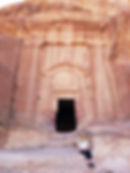
On our first day we started on the Main trail, continuing past the Siq and the Treasury through to the Street of Facades. From the street of Facades, we ascended the High Place of Sacrifice Trail and continued on the Wadi Farasa route towards the Lion Fountain, Garden Triclinium, Roman Soldier Tomb and Renaissance Tomb.
This makes the walk into a circular route which intersects back with the main trail at Colonnaded Street. We then walked back along the Colonnaded Street to the Street of Facades and the beginning of the Al-Kubtha trail.
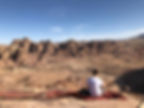
There are many steps up to the top of the Al Kubtha trail, regularly advertised on the climb up as ‘the best view of Petra’ but there is a small, shaded store with cushions to sit and enjoy the view and purchase refreshments after your ascent.

Petra Day 2
On our second day we hiked the ‘back route’ to reach Ad-Deir (the Monastery). Most people will walk from the main trail and ascended the Ad-Deir route up to the Monastery, which involves a tough climb of over 900 steps! The ‘back route’ into Petra begins in Little Petra, but you will join further along the route.
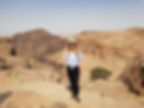
We stayed in a fantastic little B&B in Petra with a wonderful lady called Patricia. She not only provided us with a 5am breakfast to enter Petra on our first day, but she also tipped us off about the back route entrance to the Monastery.
She arranged for her taxi driver friend to take us to the drop off point. This route is not so well known, but it is discernible on Google Maps as ‘Back Door hiking route to the Monastery’, not too far from the Seven Wonders Bedouin camp. You can be dropped off by the side of the road here and then walk along the 4x4 track to the back door ticket entrance. You should aim to already have your Jordan Pass/Petra entrance ticket as it Is possible someone will check it here – but there are no tickets sold.
Taking this route, you will be rewarded with beautiful mountain views along your hike and, after around an hour and a half to two hours will see the Monastery appearing before you.

The Monastery is Petra’s largest temple. There is an area selling refreshments and benches with parasols to rest up. Once you have finished admiring the Monastery up close it is time to return to the heart of Petra. The 900 steps do not take long to descend, and we did think how grateful we were to not have to climb them! Be sure to stop on your way down at the Lion Triclinium – a tomb with a carved Lion adorning either side of the entrance.
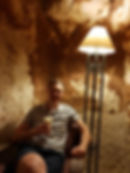
After two busy days exploring Petra, we rewarded ourselves on the 2nd evening with some drinks in the ‘oldest bar in the world’ – the cave bar within the Petra Guest House Hotel.
Many visitors like to experience Petra by Night during their visit. We opted not to since we had heard the whole experience can become rather chaotic due to the number of people, but here is the link in case you are keen
Dead Sea – 4 nights
Route: Petra (Wadi Musa) – Wadi Mujib Distance: 194km Journey Time: Approx. 2 hours 30 mins
Route: Wadi Mujib – Dead Sea Distance: 72km Journey Time: Approx. 1 hour 40 mins.
This morning you will be checking out of your Petra accommodation and heading towards the Dead Sea. The Dead Sea is a landlocked Salt Lake sandwiched between Jordan and Israel. It is the lowest point on Earth and the high salt content in the water, fluctuating around 31%, gives you a natural buoyancy and means you can effortlessly float. The mud from the dead sea also has a whole host of benefits and at some hotels you can indulge in a mud massage!

On your way from Petra to the Dead Sea it is well worthwhile having your swimsuit to hand and stopping off Wadi Mujib as a unique stop off along the Kings Highway. Generally, Wadi Mujib canyon is accessible between April and October and here you can go on a canyoning adventure! The Siq trail is very picturesque. It is the most accessible of all the trails and the one we completed. Saying that, be prepared to climb, scramble and slide into water. You will be kitted out in a compulsory life jacket (waterproof shoes and a dry bag are also available for hire) and then you will cross a bridge and descend a ladder into the canyon. To begin with you will be walking in water around calf height but soon the canyon will begin to narrow, and you will come across faster flowing water, roped sections and steel foot holes to climb. There is a nice waterfall at the end of the trail and on your way back you can lie on your back and let the current carry you through the canyon – it was exhilarating and so much fun! Dry off and continue back in the car on the short distance to the Dead Sea area of hotels.

We stayed in the Hilton Dead Sea Resort and Spa for our 4-night stay. This was a little bit of luxury for us – having spent a night in a tent in the desert we justified a bit of a splurge on a beautiful sea view room. I chose the hotel for its location, it is right on the seafront with a lift that takes you all the way down to the ‘beach’ which was perfect for floating in the sea, mud massages and relaxing with a book in one of the cabanas. It was also close to the Samarah Mall which had a couple of alternative places to eat. The restaurants in the Hotel were lovely but pricey, especially for alcohol (we’re talking £40 for a very normal bottle of wine), so for a couple of nights we opted for the hearty sports bar ‘Buffalo Wings and Rings’ with its chicken wings, gyros and pitchers of beer. Take the next couple of days to completely relax after days of hiking and exploring.

Route: Dead Sea - Jerash Distance: 96km Journey Time: Approx. 1 hour 40 mins.
On the day of your check-out from the Dead Sea you will be returning your rental car near Amman airport. Before you do, consider a morning trip to Jerash. The ancient city of Jerash is considered to be one of the best-preserved sites of Roman architecture outside of Italy. Much of the City was destroyed by an earthquake in 749 AD, but you can still tour the remains of the Oval Forum, the Temple of Artemis, Theatres and Nymphaeum. Jerash, dubbed ‘the Pompeii of the East’ is around an hour and thirty-minute drive from the Dead Sea and then around a one-hour drive from Amman airport.


We had a mid-afternoon flight departure to Cairo, so opted to leave for Jerash around 6:30am in the morning to get to Jerash for its 8am opening time (during Ramadan hours). This gave us plenty of time to tour the historic site. Two to three hours is sufficient to see the highlights of Jerash.
After your visit, head back to Amman to return your rental car and then continue on to the airport (Monte Carlo Rent A Car shuttled us back to the airport from their offices nearby) – it is time to head to Egypt!
Route: Jerash – Queen Alia Airport Distance: 75km Journey Time: Approx. 1 hour 10 mins.
Egypt Cairo – 2 nights
After a short 90-minute flight, you will be arriving in Cairo. There is no time difference between Jordan and Egypt, so if you visited Jerash this morning you should be landing into Cairo in the late afternoon.
Egypt is an incredible country with the most phenomenal history, much of which is still standing for you to explore. Generally, we like to travel independently where possible, but in Egypt we opted to take a 7-night tour with a well-regarded local company – Memphis Tours. There are so many incredible sights in Egypt that you really benefit from having an Egyptologist to guide you. For us, it really enabled us to get the most out of our experience and also allowed us a chance to relax on the organisation front. I found Memphis Tours through Tripadvisor and chose them for their fantastic reviews and flexibility with their multi-day tours. Over a series of emails, I was able to arrange for us a 7-night tour, starting and ending in Cairo with a 4-night Nile cruise in the middle. 4 - night cruises generally depart from Luxor on Mondays and this fit in perfectly with the timing of our trip and arrival date. The company were accommodating when we discussed upgrading our Nile Cruise boat (we chose the MS-Mayfair, and it was beautiful) and arranged a visit to Abu Simbel temple for us as well.
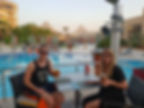
As soon as we arrived in Cairo it was immediately obvious that it was a hectic place, and the roads were chaotic – we certainly would not recommend hiring a car here if you chose to travel independently! Fortunately, our driver was very professional, and we were soon at our hotel. We checked in and spent the first evening with a cold beer by the pool with a view of the Pyramids – a sneak peak ahead of our tour kicking off the following day.

On your first full day in Cairo, you will be meeting your Cairo Egyptologist and then you will be on your way to visit one of the seven wonders of the ancient world: the Great Pyramids of Cheops, Chefren and Mykerinus. These incredible structures were built some 4500 years ago as tombs for the Pharaoh’s filled with treasures for their use in the afterlife. Though the tombs have long since been plundered and emptied, it is still possible to go inside the Great Pyramid of Cheops.
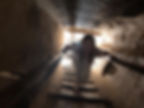
If you are claustrophobic, we recommend you do NOT attempt this – you will be ascending into the burial chamber through a very narrow passageway and the air became very stuffy the further in you went. Back outside you can continue touring the Giza plateau, see the Great Sphinx of Giza and take a camel ride out to get a postcard perfect view of the Pyramids.



After your visit to the Giza plateau, you will have the opportunity to visit the Egyptian museum. In 2022 the museum is due to open in its new, state of the art, home nearer the Pyramids and will lay claim to being the largest archaeological museum in the world.
The existing museum, in Tahir square, is already huge and is overflowing with artefacts, including the famous golden mask of King Tutankhamun. Spend a couple of hours here at least to fully appreciate everything on display.
Nile Cruise – Day 1 – Luxor East Bank: Karnak and Luxor Temple

This morning you will board a short flight from Cairo to Luxor and transfer to your Nile cruise boat.
Our boat, the MS Mayfair, was beautifully decorated and had good sized cabins with floor to ceiling windows for us to watch the Nile as we floated on by.
There was a restaurant where we had breakfast, lunch and dinner and all meals on this ship were brilliant. There were only around 20 of us on board, on a boat designed for around 150 passengers, but the crew ensured the full dining options were available and all dietary requirements were catered for.
There was also a lounge/bar on board, a sundeck with a plunge pool and a sauna.
After checking into your room, you will prepare for your first cruise excursion where you will visit Karnak Temple and Luxor Temple.

The temple complex of Karnak is immense – it covers more than 2 square kilometres and is dedicated to the gods Amun-Re, Mut and Montu.

The precinct of Amun-Re is the largest and houses the architectural marvel of the hypostyle hall with its 134 giant sandstone columns. An avenue of sphinx’s runs from the Temple of Amun at Karnak through to the Temple of Luxor.

Luxor Temple was mostly constructed by pharaohs Amenhotep III and Ramesses II and has an impressive 80 ft obelisk at the front of the temple – there used to be two but one now sits in Paris.

Inside there are pharaoh statues and main pylons (walls) with carvings showing Egyptian chariots in battle. Towards the rear of the temple is a granite shrine dedicated to Alexander the Great.

After touring both temples with your Egyptologist guide, return to your boat for dinner and rest up for a big day at the Valley of the Kings tomorrow!

Nile Cruise – Day 2 – Luxor West Bank: Valley of the Kings
This morning you will be visiting the Royal Cemetery for 62 Pharaohs- the Valley of the Kings. The valley became a royal burial ground for pharaohs such as Tutankhamun, Seti I, and Ramses II as well as Ramses’ sons and other elite members of society. We were absolutely blown away during our visit. Each tomb is unique, but generally consists of a corridor descending to a burial chamber which would house the stone sarcophagus.

There are elaborate stories etched into the walls of the corridors, colourfully and painstakingly depicting scenes of the afterlife and other funerary compositions such as the ‘Book of Night’ portraying Nut, the sky-goddess spread out across the heavens.

Access to some tombs requires an extra ticket – general entrance to Valley of the Kings offers access to 3 tombs and it is a bit of potluck depending on which are open and not undergoing restoration at the time.

You then have the option to purchase entry tickets to KV62 (King Tut) for 80 EGP – approximately £3.50, and the tomb of Ramses VI for an additional 50EGP – approximately £2. The rules on photography in the tombs seems to vary regularly. When we visited, we were able to pay an extra fee to take photos on our camera phone in 3 tombs and on entry to the tomb someone from security would punch a hole in our photo pass. KV 62 – The tomb of Tutankhamun is in fact one of the smallest and modestly decorated tombs in the Valley of the Kings. Because the Pharaoh died at such a young age there was little time to build his tomb.

Our favourite tomb was that of KV9 – the tomb of Ramses V and Ramses VI. Since the entry to Ramses VI required an additional fee, we found it was far less busy than some of the other tombs and at one point we even had it all to ourselves.
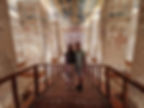
It was amazing descending through the corridor to the burial chamber and quietly being able to take in the incredibly intact hieroglyphs and paintings. The burial chamber in Ramses VI is also a feast for the eyes. A magnificent representation of the goddess Nut spans across the ceiling, which is also adorned in deep blue and stars for the night sky.

Round-off your time on the West Bank by driving a small distance on from the Valley of the Kings to explore the impressive Temple of Hatshepsut. This large structure, nestled into the foot of the cliffs, is a dedication to the female Pharaoh Hatshepsut, who was renowned for her unprecedented power for a woman which included the adoption of the full titles and attire of a Pharaoh.

After your visit to the West Bank, the afternoon can be spent at leisure. Relax on the boat as you start to sail towards Edfu.

It is worth noting that many travellers opt to take a Hot Air balloon flight over the Valley of the Kings on this morning of the trip. Those in our tour group that chose to do this had a fantastic time and spoke highly of the experience. We opted against it in part due to some concern over the safety record of balloon flights in the Luxor area and the early morning start – we saved that for our trip to Abu Simbel a couple of days later!
Nile Cruise Day 3 – Edfu and Kom Ombo
Today you will be visiting the Temple of Horus (Edfu) and the Temple of Kom Ombo.

The Temple of Horus in Edfu is perhaps the most complete ancient monument in all of Egypt since part of its roof remains intact. The temple was preserved by being buried by desert sand and was uncovered in the mid-19th century. As well as its completeness, the temple is known for its two large granite statues of falcons, which are a depiction of Horus – the son of Isis and Osiris and the god of the sky, who was often portrayed as a falcon.


Kom Ombo Temple is interesting because it is dedicated to not one, but two, gods. It is dedicated to both Sobek – the crocodile god and Haroeris – Horus the elder. This dual dedication is reflected in the layout of the temple since it is perfectly symmetrical through its main axis with twin entrances and two connected hypostyle halls.
The temple is also known for an engraving which is believed to be amongst the first to represent medical and surgical instruments. The scene also depicts two women using birthing chairs – this really shows how advanced Egyptian medical science was at the time.


Once you have visited the temples, the rest of the day will once again be at your leisure.
Read a book on the sundeck, explore on land a little more or have a cocktail in the lounge bar.
Later this afternoon you will start sailing on to Aswan and it is worth popping up on deck to watch when the boat pauses to pass through Esna lock.
Nile Cruise Day 4 – Abu Simbel This morning be ready to start your day super early as you will be leaving the boat around 5:30/6am to make the journey by road to Abu Simbel. You will be covering over 280 km in around 3 hours of driving, but we promise you the early start will be well worth your effort.
We slept in the car for part of the journey and arrived at Abu Simbel shortly after 9am.
Before you head out to the Temple site there is a hall you pass through where you can watch a video explaining how the site came to be. The story of Abu Simbel really is quite an incredible engineering feat and it really is worth taking some time to understand before you see it in the flesh.
The original construction of Abu Simbel took around 20 years. Ramses II, the most powerful King of Egypt’s 19th Dynasty, had built Abu Simbel to symbolise the power and supremacy of Egypt, intimidating Ramses’ enemies and seating himself amongst the gods. Abu Simbel comprises of two temples – one is dedicated to Ramses II and is flanked by 4 ginormous statues of Ramses, the second is dedicated to his wife, Queen Nefertari.

The complex is believed to be a project of Ramses’ ego, pride and love.
In the 1960’s, the entire complex was moved to a site on higher ground after plans to dam the Nile in 1960 threatened to submerge the temple in its current location. What followed was an incredible effort from multiple countries, forming committees and researching possible rescue approaches for Abu Simbel and other monuments of Nubia. To relocate Abu Simbel was no simple task.

Multiple methods for relocation were proposed and eventually it was decided that moving Ramses temples to higher ground would involve cutting the complex, including the cliff it was built into, into more than 1000 blocks. Dismantling and re-constructing the site was meticulous and a colossal effort which took more than 2 years to complete. Finally, in 1968, Abu Simbel was inaugurated in its new, higher location. What is particularly incredible about this rescue mission was the precision of the re-build. Previously, Ramses’ temple was curated in such a way that sunlight would flow through the temple twice a year, illuminating the statues of Ramses, Ra (the sun god) and Amun (the king of the gods). Only Ptah, the god of darkness, remains in the shadow.

This phenomenon would occur once on Ramses’ birthday and again on the anniversary of the day he took the throne. The relocation of the complex resulted in these dates moving by one day – the Sun Festival illumination now takes place on the 22nd February and the 22nd October.
Take your time exploring both the temple of Ramses II and that of Queen Nefertari. They are both incredible and this was absolutely the highlight of our Egypt trip.

Nile Cruise Day 5 – Aswan, Philae Temple and the Unfinished Obelisk
Today you will be taking an afternoon flight back to Cairo, but there is plenty of sightseeing left to be done first!
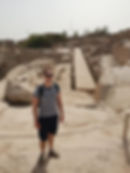
After you have checked out of your cabin and disembarked, you will be driven first to a quarry to see the Unfinished Obelisk.
The unfinished obelisk is the largest known ancient Egyptian obelisk and, if it had been erected, would’ve stood at around 42 meters tall! This is incredibly impressive given it is carved out of a single piece of solid granite. We saw obelisks standing in the temple of Karnak at the beginning of our Nile journey and were amazed at how the Egyptians in all their cleverness had managed to centre this enormous piece of rock on top of a small stone base. It demonstrated once again how ahead of their time they were architecturally and mathematically. After seeing the unfinished obelisk, you will then visit the temple of Philae.


Like Abu Simbel, the temple of Philae was moved from its original location after the flooding of Lake Nasser. It now sits, prettily, on the small island of Agilika and is reachable by a small boat ride.
This temple is dedicated primarily to the goddess Isis. It is smaller than some of the other temples you will have visited along the Nile, but it is nonetheless impressive thanks to the lovely views of the river and the knowledge that the entire structure has been resituated.

The final stop in Aswan, and of your Nile cruise, will be the Aswan High Dam. This dam was completed in 1970 and is the largest embankment dam in the World. Its reservoir is what formed Lake Nasser and the dam’s creation enables control of the annual Nile flood. The site is very important for the Egyptian economy and it also makes for a nice photo stop on your way to Aswan airport for your short return flight to Cairo.

Cairo – 1 night
It is likely you will have landed into Cairo in the mid-afternoon. If your international flight home is not until late the following day you may wish to use your final evening to explore the City. For us, we were departing very early the following morning so took the time to relax by the pool and have a leisurely dinner, reflecting on all of the incredible things we had seen over the past two weeks.